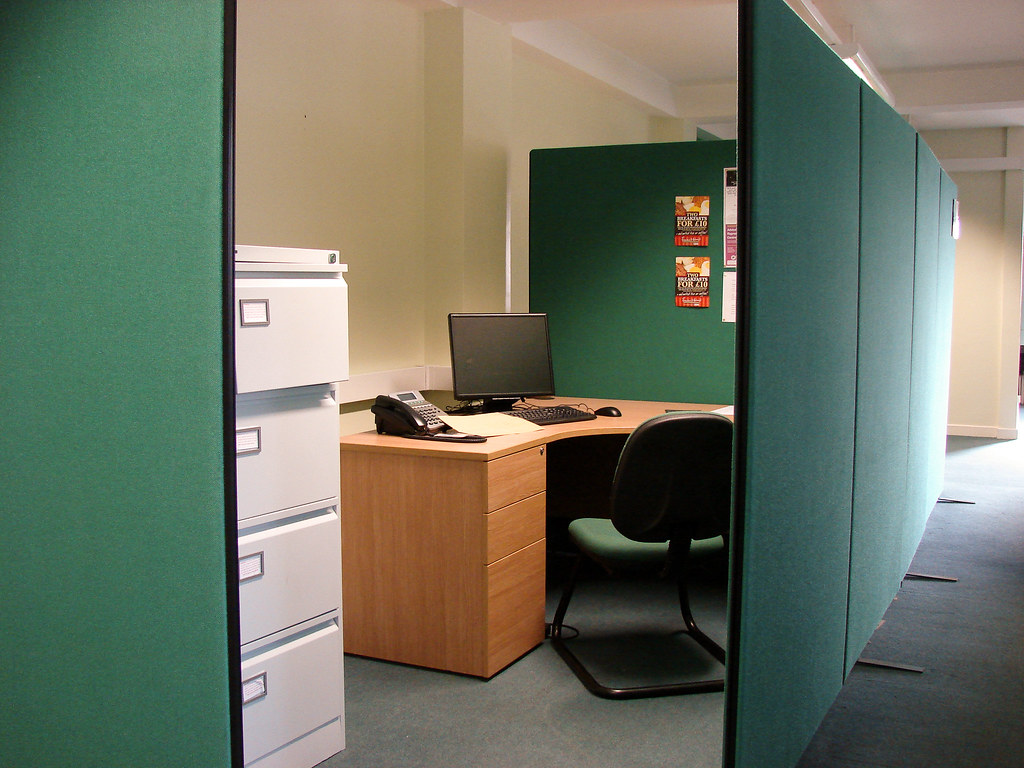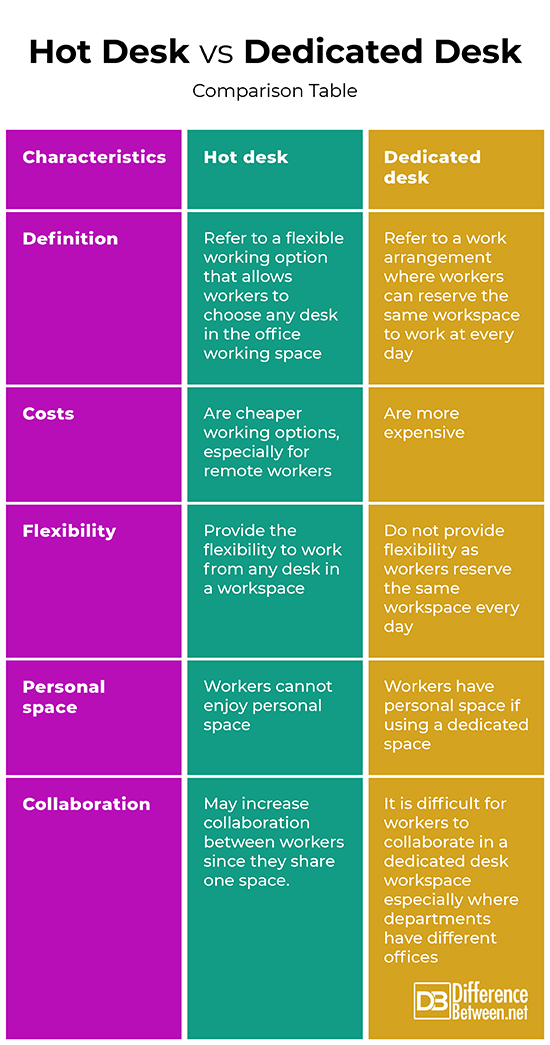Difference Between Hot Desk and Dedicated Desk
Co-working spaces have become common in the recent past. Businesses as well as remote workers including freelancers and contractors no longer need to rent an office, thanks to the variety of different remote working options. This flexibility reduces office space costs, enabling small businesses and start-ups to channel their funds to other essential sectors such as marketing and consulting. Co-working spaces offer people different working plans based on their needs. In this article, we will look at two types of co-working space arrangements, namely: hot desk and dedicated desk.

Hot Desk
This is a flexible working option that allows workers to choose any desk in the office working space. This means that workers do not have a permanent desk. It can be used by companies, freelancers and other remote workers.
While hot desking offers many benefits to businesses, it also has disadvantages.
Let’s start with the advantages
- Hot desks offer much-needed flexibility in terms of utilization of space. Due to the flexible desk arrangements, hot-desking allows spaces to accommodate more people.
- It offers the perfect workspace for consultants, remote workers and even part-time workers since they do not need their work desks.
- The affordability that comes with hot-desking is unmatched. Businesses also get more productivity even by using a smaller working space. This means that businesses that take advantage of hot desking have better chances of survival and even expansion due to the reduction of overheads.
- Hot desks means that workers are not accustomed to routines. This keeps them on their toes and helps them adapt easily to new working environments and challenges.
- Increased collaboration- Since workers are not confided in one little office, they can move around and interact with others. This increases collaboration among employees.
- Reduce office clutter- It is unlikely that workers will leave the desk cluttered at the end of the end.
Here comes the drawbacks;
- With hot-desking, communication can become difficult especially when the workspace is not properly organized. You might find that some days you have more employees in than expected, leaving some with no spaces.
- It is easy for the hierarchy in a company to be ignored. This is because the arrangement removes traditional leadership authority. This can lead to disruption between the subordinates and management.
- Setting up IT tools can be difficult.
- For employees, sitting at a different desk can be disrupting. More-so, it can be disruptive especially to people who love their personal spaces.

Dedicated Desk
This is a work arrangement where workers can reserve the same workspace to work at every day. In most dedicated workspaces, workers get to enjoy other amenities such as free beverages, shared office equipment like printers and private storage facilities.
Here are the advantages of a dedicated desk;
- Provides teams with personal space- Since each person reports to a dedicated desk each day, teams get to enjoy a private space. In most dedicated desk agreements, workers can even leave their valuables, documents and other work-related items.
- Enhances efficient collaboration- Dedicated desks ensure teams remain collaborative. It is easy to identify different departments and channel resources and help to teams when they are grouped.
- Personalization- Workers can personalize their desks. For instance, a worker who is not as productive while using the office keyboard can bring in their own.
However, dedicated desks have some disadvantages.
- Workers are less flexible when it comes to the workspaces. As such, productivity may be diminished if employees are placed in workstations that do not suit their work style.
- There is a significant decrease in inter-departmental social interaction
Similarities between Hot desk and Dedicated desk
- Both offer flexible working spaces for businesses, freelancers and other remote workers
Differences between Hot desk and Dedicated desk
Definition
Hot desks refer to a flexible working option that allows workers to choose any desk in the office working space. On the other hand, dedicated desks refer to a work arrangement where workers can reserve the same workspace to work at every day.
Costs
Hot desks are cheaper working options, especially for remote workers. On the other hand, dedicated desks are more expensive.
Flexibility
While hot desks provide the flexibility to work from any desk in a workspace, dedicated desks do not provide flexibility as workers reserve the same workspace every day.
Personal space
With a hot desk, workers cannot enjoy personal space. On the other hand, workers have personal space if using a dedicated space.
Collaboration
Hot desks may increase collaboration between workers since they share one space. On the other hand, it is difficult for workers to collaborate in a dedicated desk workspace especially where departments have different offices.
Hot desk vs. Dedicated desk: Comparison Table

Summary of Hot desk vs. Dedicated desk
Hot desks refer to a flexible working option that allows workers to choose any desk in the office working space. On the other hand, dedicated desks refer to a work arrangement where workers can reserve the same workspace to work at every day. While both have pros and cons, both provide excellent work options while helping businesses and remote workers save costs.
- Difference Between Profit Center and Investment Center - July 2, 2022
- Difference Between Anti-Trust and Anti-Competition - June 6, 2022
- Difference Between Stocktaking and Stock Control - June 6, 2022
Search DifferenceBetween.net :
Leave a Response
References :
[0]Webber M & Douglas T. Working Remotely: Secrets to Success for Employees on Distributed Teams. Simon and Schuster, 2020. https://books.google.co.ke/books?id=7lTDDwAAQBAJ&pg=PA15&dq=remote+working&hl=en&sa=X&ved=2ahUKEwiYkYjX6qDvAhURqXEKHX0EC7wQ6AEwAXoECAYQAg#v=onepage&q=remote%20working&f=false
[1]Management Association, Information Resources. Remote Work and Collaboration: Breakthroughs in Research and Practice: Breakthroughs in Research and Practice. IGI Global, 2017. https://books.google.co.ke/books?id=vWdxDgAAQBAJ&pg=PA733&dq=remote+working&hl=en&sa=X&ved=2ahUKEwiYkYjX6qDvAhURqXEKHX0EC7wQ6AEwBnoECAcQAg#v=onepage&q=remote%20working&f=false
[2]Siddons S & Nickson D. Remote Working. Routledge, 2012. https://books.google.co.ke/books?id=uBxcmOVJDNYC&printsec=frontcover&dq=remote+working&hl=en&sa=X&ved=2ahUKEwiYkYjX6qDvAhURqXEKHX0EC7wQ6AEwAHoECAEQAg#v=onepage&q=remote%20working&f=false
[3]Image credit: https://live.staticflickr.com/5248/5342159761_e1c6a3bb8a_b.jpg
[4]Image credit: https://live.staticflickr.com/4021/4367134991_9e148c10b2_b.jpg
